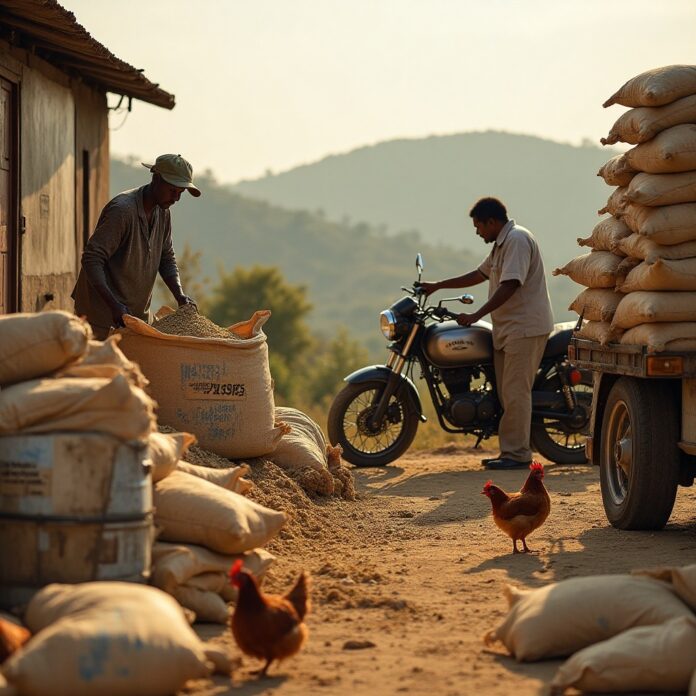Small-scale poultry feed production isn’t just about grinding grains—it’s a lifeline for rural economies. For feed manufacturers (large and small), the stakes are high: balancing nutrition, slashing costs, and reaching farmers in areas where roads dissolve in rain. Let’s cut through the noise and tackle these challenges head-on.
Nutrient Balancing for Small-Scale Feed Production
2.1 Understanding Poultry Nutritional Requirements
Chickens aren’t one-size-fits-all diners. A broiler’s diet differs wildly from a layer’s. Layers need 3-4.5% calcium for eggshells; chicks require 20-22% protein for growth. The National Research Council (NRC) sets benchmarks: starter feeds need 23% protein, layers 16% protein plus calcium. In Nigeria, swapping soybean meal for cassava peels (carbs) or black soldier fly larvae (protein) cuts costs without compromising nutrition.
2.2 Formulating Cost-Effective Feed
Local ingredients are survival tactics. Kenyan farmers saved 30% using cassava byproducts; Thai producers use rice bran. Balance maize (energy), soybean (protein), and fishmeal (amino acids). But overloading corn causes fatty liver syndrome in layers. Use a feed formulation spreadsheet to track protein, calcium, and cost per kg.
2.3 Quality Control and Testing
Moldy feed kills flocks. Proximate analysis tests moisture, protein, and toxins. For small ops, a $20 moisture meter prevents spoilage. In humid climates, silica gel in woven bags works wonders.
Cost-Effective Packaging Solutions
3.1 Material Selection
Jute breathes (less mold) but polyethylene extends shelf life. A Ugandan startup saved 40% with recycled rice sacks. Rural farmers prefer 1-5kg bags—bulk is too pricey.
3.2 Small-Scale Packaging Machinery
Skip the $10k sealer. A manual heat sealer ($150) and repurposed scales work. Run pellet mills at night to exploit off-peak electricity—cuts bills by 30%.
3.3 Storage and Preservation
In Vietnam, clay pots lined with banana leaves fight humidity. Colombian cooperatives use QR codes on bags, reducing waste by 15%.
Distributing to Rural Farmers: Strategies and Logistics
4.1 Overcoming Transportation Barriers
Nepali producers use modified bicycles for 50kg sacks; Malawi relies on donkey carts. Partner with motorcycle taxis—a Tanzanian cooperative cut delivery times by 60%.
4.2 Building Partnerships
Bangladesh trained women’s groups as distributors, spiking sales by 200%. Work directly with cooperatives—a Ugandan miller boosted profits by 18% ditching middlemen.
4.3 Marketing to Rural Audiences
Sponsor cricket tournaments (Rajasthan) or air radio jingles in local dialects. Ghana saw 90% brand recall with Twi-language ads. Demo farms in Vietnam lifted sales by 40% showing “before-and-after” hen weight.
4.4 Feedback and Adaptation
Nigerian producers added red palm oil to pellets after farmers complained about brittle feathers. Use SMS surveys—Kenyan retention rates hit 85% with quarterly formula tweaks.
Case Studies and Success Stories
Example 1: Cassava Peels Revolution in Kenya
A cooperative replaced 30% maize with cassava peels—costs dropped 30%, egg production rose 22%. Bonus: Less deforestation from burning waste.
Example 2: Solar-Powered Packaging in India
GrubTerra uses solar pelletizers to serve 5,000+ farmers. They lease machines to women’s groups—earn fees, scale cheaply.
Example 3: Schoolyard Distribution in Colombia
Feed sacks are distributed via schools, paid with chicken eggs. Enrollment rose 15% as eggs covered school fees.
Tools and Resources
- FAO’s Feed Formulation Tool: Plug in local ingredients (e.g., millet in Sudan)—Nigerian producers saved $8/ton.
- Packaging Cost Template: Compare materials. Ugandans saved $0.12/bag with stamped jute.
- Distribution Checklist: A Maharashtra company cut delivery delays from 21 days to 6 by aligning with weekly markets.
This isn’t about fancy tech—it’s ingenuity. Use cassava peels like Kenya. Package in recycled sacks like Uganda. Distribute via schools like Colombia. Start small. Iterate fast. Partner with a farmer group this week. Remember: Every sack of feed means a child eating eggs, a mother paying school fees, a village rising


